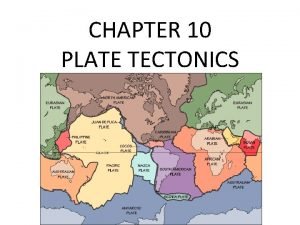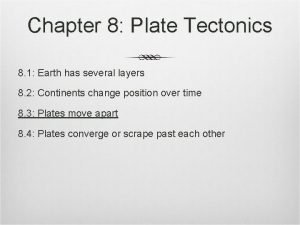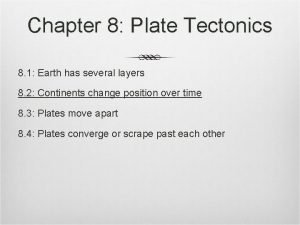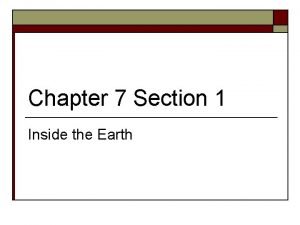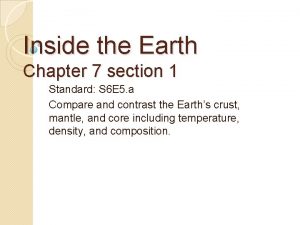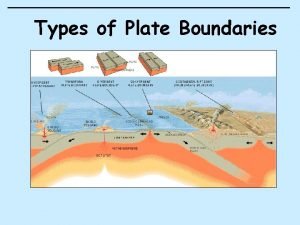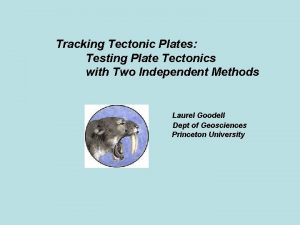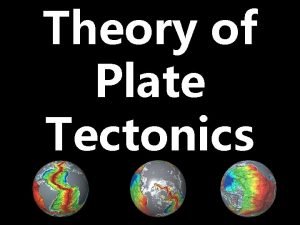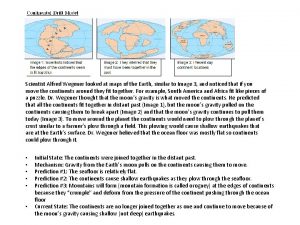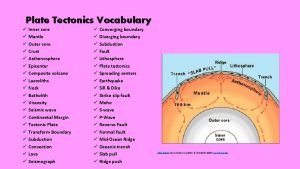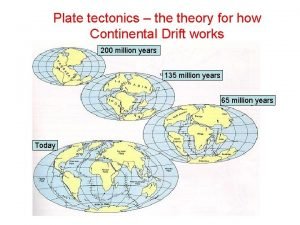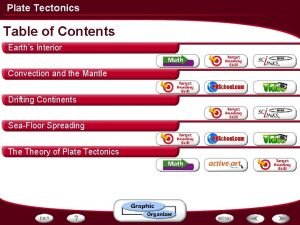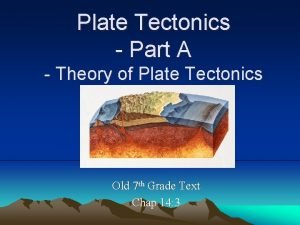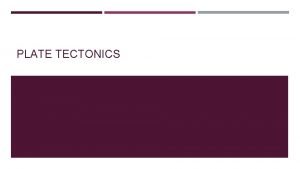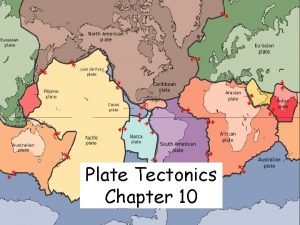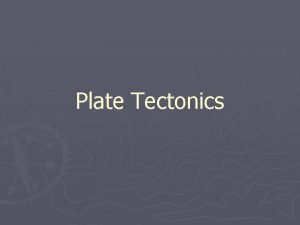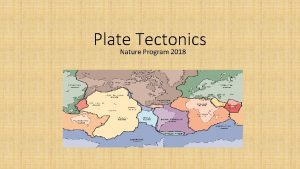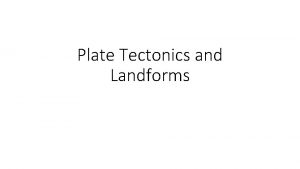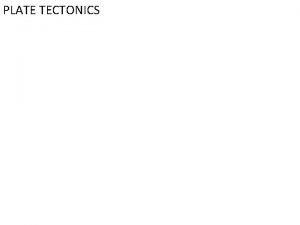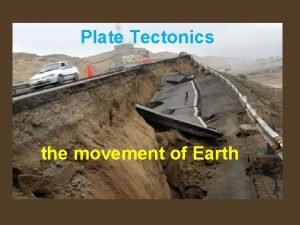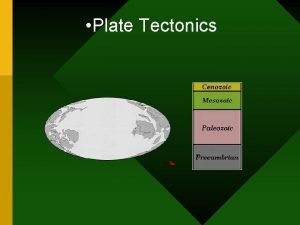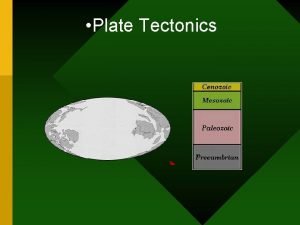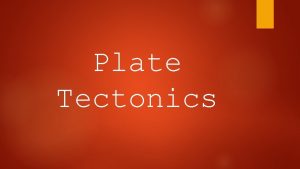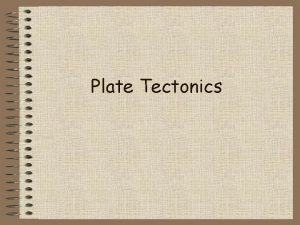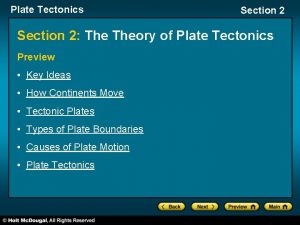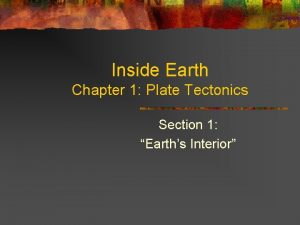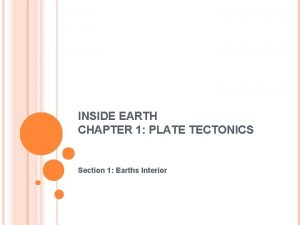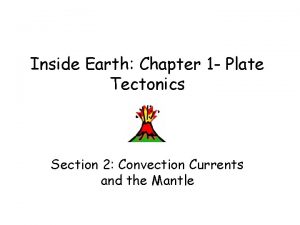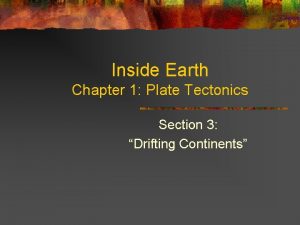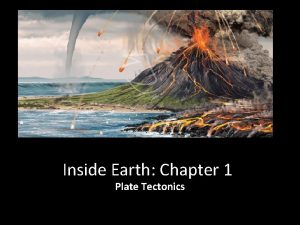Inside Earth Chapter 1 Plate Tectonics Section 4




















- Slides: 20

Inside Earth: Chapter 1 - Plate Tectonics Section 4: Sea-Floor Spreading

Guide For Reading • What is the process of seafloor spreading? • What happens to the ocean floor at deep ocean trenches?

Mapping the Mid-Ocean Ridge

Mid-Ocean Ridge • Mid-Ocean Ridge: The undersea mountain chain where new ocean floor is produced; a divergent plate boundary

Sonar • Sonar: A device that determines the distance of an object under water by recording echoes of sound waves

Checkpoint (Page 34) What device is used to map the ocean floor? • The sonar is used to map the ocean floor • Sonar bounces sound waves off underwater objects and then records the echoes of these sound waves • The time it takes for the echo to arrive indicates the distance to the object

Evidence for Sea-Floor Spreading

Sea-Floor Spreading • Sea-floor spreading: The process by which molten material adds new oceanic crust to the ocean floor

Checkpoint (Page 37) What evidence did scientists find for sea-floor spreading? • Evidence from molten material • Evidence from magnetic stripes • Evidence from drilling samples

Evidence From Molten Material • Alvin’s crew found strange rocks shaped like pillows or like toothpaste squeezed from a tube • Such rocks can form only when molten material hardens quickly after erupting under water • The presence of these rocks showed that molten material has erupted again and again from cracks along the central valley of the mid-ocean ridge. http: //www. pmel. noaa. gov/vents/nemo/explorer/concepts/pillow_lava. html

Evidence From Magnetic Stripes • Scientists discovered that the rock that makes up the ocean floor lies in a pattern of magnetized “stripes” • 780, 000 years ago, magnetic poles reversed themselves • If they reversed today, the needle in a compass would point south instead of north • The rock in the ocean is made of iron, which began as molten material

Evidence From Drilling Samples • When scientists sampled the rocks, they found that the further away from the ridge the rocks were the older they were • The younger rocks were always in the center of the ridges

Subduction at Deep-Ocean Trenches

Deep-Ocean Trenches • Deep-Ocean Trenches: A deep valley along the ocean floor through which oceanic crust slowly sinks towards the mantle

Subduction • Subduction: The process by which oceanic crust sinks through a deepocean trench and back into the mantle; a convergent plate boundary

Guide For Reading: What happens to the ocean floor at deep ocean trenches? • At deep-ocean trenches, two plates collide causing the denser of the two plates to dive back to the mantle. This process is known as subduction. • Over tens of million of years, this material melts back into molten material and may rise again as new oceanic crust.

Guide For Reading: What is the process of sea-floor spreading? • At the mid-ocean ridge, molten material rises from the mantle and erupts. The molten material then spreads out, pushing older rock to both sides of the ridge. • Over tens of millions of years, the process continues until the oldest ocean floor collides with the continental crust • The more dense oceanic crust subducts (sinks) back into the mantle at a deepocean trench

Subduction and Earth’s Oceans

Subduction in the Pacific Ocean • Subduction in the Pacific Ocean is occurring at a greater rate than seafloor is expanding • This is caused by the large amount of trenches

Subduction in the Atlantic • The Atlantic Ocean is expanding at a greater rate than subducting • This is because of the low number of trenches in the Atlantic • Over time the entire ocean gets larger and pushes against the continents
 Fossils as evidence of continental drift
Fossils as evidence of continental drift Chapter 8 plate tectonics
Chapter 8 plate tectonics Chapter 8 plate tectonics
Chapter 8 plate tectonics Chapter 7 section 1 inside the earth answer key
Chapter 7 section 1 inside the earth answer key Three compositional layers of the earth
Three compositional layers of the earth Composition of the earth's crust
Composition of the earth's crust Plate tectonics vs continental drift
Plate tectonics vs continental drift Boundary features
Boundary features Evidence of the theory of plate tectonics
Evidence of the theory of plate tectonics The plate tectonics theory states that
The plate tectonics theory states that Compare continental drift and plate tectonics
Compare continental drift and plate tectonics Compare continental drift and plate tectonics
Compare continental drift and plate tectonics Plate tectonics webquest answers
Plate tectonics webquest answers Inner core vocabulary
Inner core vocabulary Rodinia
Rodinia Plate tectonics
Plate tectonics Plate tectonics definition
Plate tectonics definition Driving force of plate tectonics
Driving force of plate tectonics Plate boundaries
Plate boundaries Summarize the theory of plate tectonics
Summarize the theory of plate tectonics Arthur holmes contribution to plate tectonics
Arthur holmes contribution to plate tectonics
